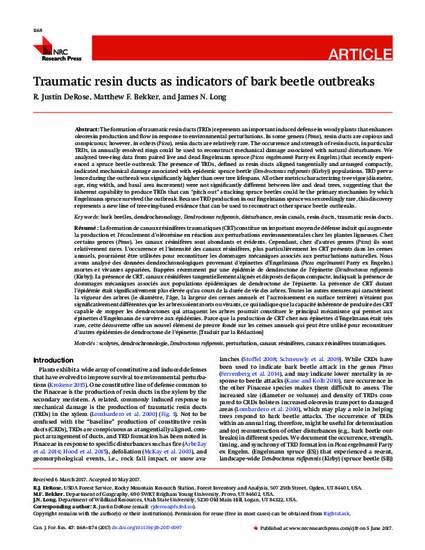
Article
Traumatic Resin Ducts as Indicators of Bark Beetle Outbreaks
Canadian Journal of Forest Research
(2017)
Abstract
The formation of traumatic resin ducts (TRDs) represents an important induced defense in woody plants that enhances oleoresin production and flow in response to environmental perturbations. In some genera (Pinus), resin ducts are copious and conspicuous; however, in others (Picea), resin ducts are relatively rare. The occurrence and strength of resin ducts, in particular TRDs, in annually resolved rings could be used to reconstruct mechanical damage associated with natural disturbances. We analyzed tree-ring data from paired live and dead Engelmann spruce (Picea engelmannii Parry ex Engelm.) that recently experienced a spruce beetle outbreak. The presence of TRDs, defined as resin ducts aligned tangentially and arranged compactly, indicated mechanical damage associated with epidemic spruce beetle (Dendroctonus rufipennis (Kirby)) populations. TRD prevalence during the outbreak was significantly higher than over tree lifespans. All other metrics characterizing tree vigor (diameter, age, ring width, and basal area increment) were not significantly different between live and dead trees, suggesting that the inherent capability to produce TRDs that can “pitch out” attacking spruce beetles could be the primary mechanism by which Engelmann spruce survived the outbreak. Because TRD production in our Engelmann spruce was exceedingly rare, this discovery represents a new line of tree-ring-based evidence that can be used to reconstruct other spruce beetle outbreaks.
Disciplines
Publication Date
2017
DOI
https://doi.org/10.1139/cjfr-2017-0097
Citation Information
James N. Long. "Traumatic Resin Ducts as Indicators of Bark Beetle Outbreaks" Canadian Journal of Forest Research Vol. 47 (2017) p. 1168 - 1174 Available at: http://works.bepress.com/jameslong/208/
